Other Perennials & Shrubs
Some plants are not for sale online. Please call 802-426-3506 for mail order.

Actaea
Until about 5 years ago before being reclassified, Actaea was known as Cimicifuga. You might remember it or still call it by that name. It blooms later on in July and on into fall with bottle brush flowers that are a magnet to pollinators. We recommend against planting it near doors or unscreened windows because the fragrance of the blooms is a magnet to hornets and wasps. We carry various varieties from year to year from the shorter Pink Spike and Brunette to Hillside Black Beauty, James Compton and the 8 foot tall A. atropurpurea. You'll see some mature A. atropurpurea growing in the top row of our hosta display garden.

Asclepias
As interest has grown over all pollinators, interest in Asclepias has grown too. We grow a limited number of Asclepias incarnata, the pink flowered, thin scaped swamp milkweed each year. We also grow Asclepias tuberosa, known as butterfly weed or plant, or pleurisy root. It has orange flowers. Despite many, many requests we have yet to grow and offer Asclepias syriaca, the common milkweed so prevalent in New England.

Astilboides Tabularis
If you enjoy growing taller plants to add some "vertical" to your gardens or some large leafed plants as significant attention getters bearing 5-6 foot tall flower scapes and +3 foot diameter leaves, then Astilboides tabularis deserves your attention. Many garden designers and home gardeners tell us "It's too coarse a plant for me." but there is no way you cannot like it in the right location. Each year we grow about 15 pots for sale and each year they move from our nursery to new gardens somewhere. Consider buying one to take on your journey back home.

Asters
Asters are made for fall color but it takes a special gardener intent upon season-long color to be interested in them. We usually offer a nice blue-purple appropriately named October Skies and a pink named Alma Potschke. We also grow an annual aster that we use in the cut flowers that we sell. They have strong stems and last well as a cut.
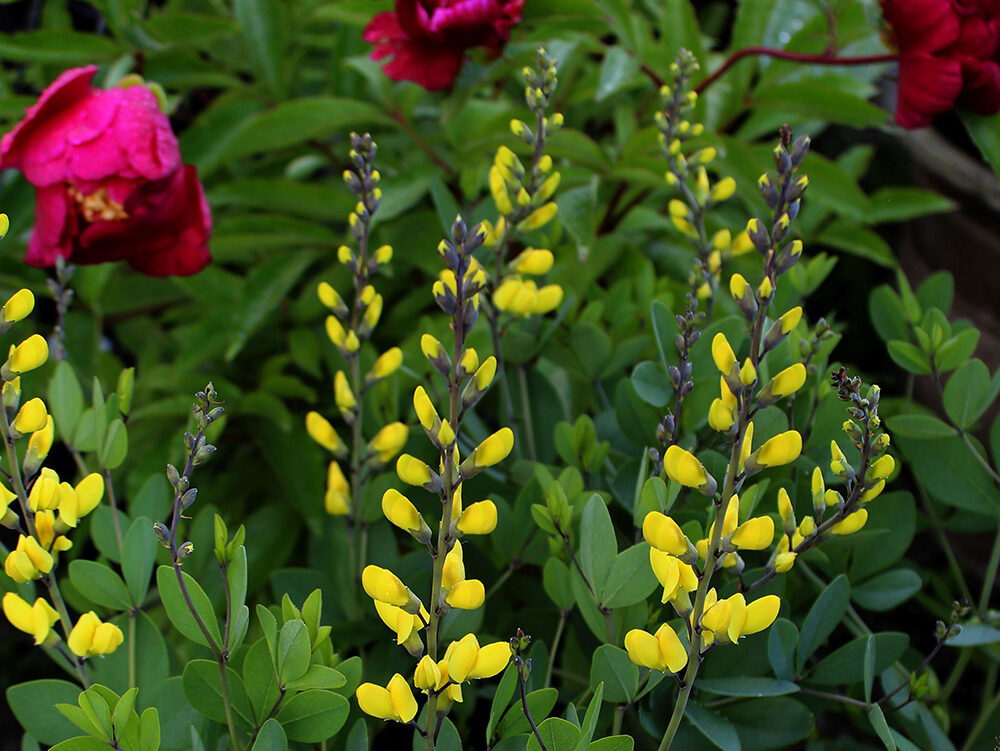
Baptisa
Baptisia is often known by its common names of False Indigo or Wild Indigo. Modern hybrids show much better self control respective of size and growth. The blue green foliage is lupine-like in appearance and is often grown now by florists to use as a bouquet filler. When the seed pods mature, black seeds are obvious. Plants should cut back to the ground each fall. We offer different varieties each year. American Goldfinch, Lemon Meringue, Blueberry Sunday, Cherries Jubilee, Grape Taffy, Pink Lemonade are examples.

Blueberries
Even before Covid we sold blueberry bushes for the antiviral benefit of the fruit. Each year we grow half a dozen varieties of 3-4 year old plants that are in bloom and will fruit for you the first year. We only grow early and mid season fruiting plants because later fruiting berries are susceptible to the drosophila fly. The plants are easy to grow and can be interplanted within your flower gardens as the leaves provide bright red autumn color. Also great to plant for budding gardeners as we never saw a child who didn't like to pick and eat blueberries.

Brunnera
Commonly known as Siberian Bugloss, this shade loving plant has heart shaped, hairy leaves, is clump-forming and spreads slowly by rhizomes. Sprays of forget-me-not blue flowers open in May and continue on for another full month. Each year we try to carry four varieties such as Alexander the Great, Silver Heart, Jack Frost. The leaf texture and color as well as deep veining make it a great companion with hostas.

Cardinal Flower
Lobelia cardinalis, commonly known as Cardinal Flower, prefers sunshine to shade but needs a moist location to do well. It grows to 3-4 feet tall with bright red blooms that hold for approximately 6 weeks during which time hummingbirds make it their friend. It does produce seeds but we have never seen any germination here at the farm.
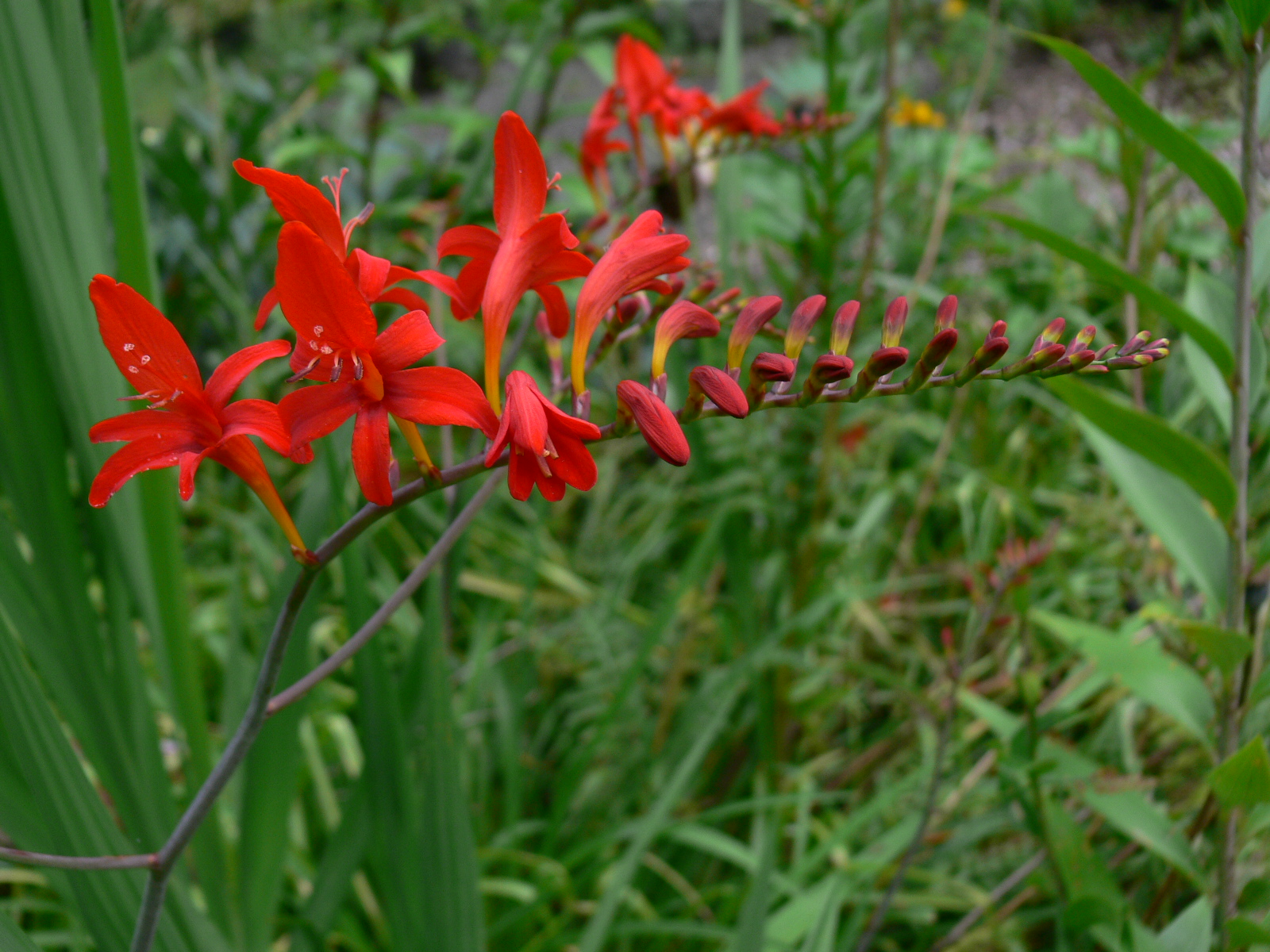
Crocosmia
Here's an interesting plant from South Africa. Although it comes in shades of pink, white and yellow, the only New England, Zone 3-4 hardy variety is Lucifier which we grow. Notice the bright red color. It must be planted in a place that will replicate its origins. Very poor soil, full sun, never under the eaves of a building or where melting snows or rains puddle and hold. Never fertilize and again--poor soil, no orgainc amendments or it won't make it. We sell 5-6 corms in a gallon to 6 quart pot. Remove from the pot, gently remove a couple inches of soil from the bottom of the root mass and plant 8" deep.
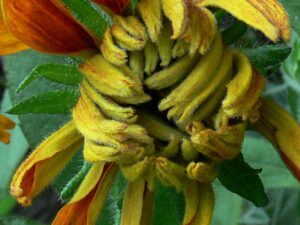
Daisies
A mixed category of daisies always available at the farm include various Rudbeckias--as pictured here-- and then various Shasta daisies, the white petaled daisy that holds well in arrangements. Some of the Rudbeckias are 8 feet tall as you will see along our garden borders where Herbstsonne grows. We also sell Helianthus 'Lemon Queen', one of the perennial sunflower types which are the preferred bloom of Vermont's number one pollinator, the bumblebee.

Echinacea
Commonly known as coneflower this member of the daisy family has antiviral properties and is widely grown even in Vermont for processing and sale for this purpose. Prefers full sun and poor soil. The pollinators prefer the original basic white and purple varieties but modern hybrids in red, yellow and orange are widely available now. We only grow those that the pollinators go for.

Elderberries
If you have visited our farm over the past several years you might have seen 3 gallon pots of various elderberries for sale. We offered them and they were very well received. Sadly for everyone, we have decided not to carry them any longer. In a time of Covid and other viruses, the antiviral properties of the fruit are powerful but so are the insects that go after these plants. The spotted winged drosophila fly, garden slugs and Japanese beetles are examples of some of the critters that do a number on elderberries. I know of no organic insecticide that will consistently control these problems. If you know differently, we would enjoy talking.

Epimedium
To us, the most difficult thing about growing epimedium is how to describe the bloom. One of the names is Bishop's hat, but some describe the blooms as nodding cups, columbine-like, like tiny butterfly wings, even spider-like. Colors range from white to yellow, orange, lilac and rose. The leaves are at times as beautiful as the flowers. From year to year we carry 2-3-4 varieties. Some you might find are a vigorous growing white, a small yellow, a nice lilac and a rose with a decorative leaf that provides color and interest all season. Track down Karen Perkins from Templeton, Massachusetts if you are interested in collecting epimediums. She's one of the best.

Eupatorium
If you enjoy monarch butterflies, here's a plant to add to your gardens. But don't stop by a New England road and dig a shovelful of the native Eupatorium purpureum or you will regret it forever. We place Boneset, the creamy white native eupatorium in that category too. Stick with hybrids that display self control and don't self seed all over. From year to year we change what we offer. E. maculatum 'Gateway', E.riesenschrin, Little Joe, Chocolate, others.

European Ginger
Asarum europaeum is that ground cover that sells itself. It's always been more popular in warmer climes such as south of the Vermont border. The dark green, glossy, shiny leaves and the blooms you might never see make it a nice companion to the perimeters of shade gardens, and adjacent to walkways and steps. Each spring we pot up 30-4 quart pots and by July they are gone.

Ferns
Ferns have always interested us. A neighbor is an authority on ferns and it seems as if he is always identifying something new that needs a classification and a name. Interest changes from year to year and we always receive requests when whatever we had for sale is gone. They have never been great sellers but for those building shade type gardens, they are good to add. Maidenhair ferns are very nice but be sure to buy the northern variety else they won't make it here. Christmas ferns are very strong and rock ferns work well on big stones or stone walls. Our favorite fern has always been a painted fern named Silver Falls. If you have visited Oregon you know the name. Terra Nova Nurseries developed it.

Grasses
We could tell stories about grasses that people shouldn't buy but we won't. George loves Karl Foerster/Calamagrostis x acutiflora and just added it to our pollinator garden last year. Beyond that we sometimes have a blue fescue but we don't get excited because grasses are only made for certain people...like Piet Oudolf.

Helianthus
If you like sunflowers you might like Helianthus 'Lemon Queen' pictured here. There are about 75 members of the genus and we grow on average 10 varieties of annual sunflowers for pollinator food and for cut flowers and then we grow 'Lemon Queen' because it is the very strongest perennial magnet we know for New England's number one pollinator, the bumble bee. 'Lemon Queen' is available each spring in 6 quart pots but it sells out early...until the next year.

Helenium
This is another member of the sunflower family. The plant pictured is named 'Salsa' and the common name for the plant is sneezeweed. They range in height from one foot to 5 feet tall. They have abundant bloom scapes and make excellent cut flowers. They come in colors that work well in any garden and look fine in the fall when some are still blooming.

Heliopsis
This is another member of the sunflower group that we grow. They are native to the dry prairies of North and South America and do not need any assistance once they are planted. We have them planted along our fences with the very tall Rudbeckia Herbstsonne and the height draws attention to surrounding plantings and encourages "Let's go see!" from customers.

Hellebores
We began growing hellebores in our hosta display garden at our house perhaps 25 years ago. They are a wonderful shade plant and along with pulmonarias are the first plants to bloom come spring. The first week of May, male hummingbirds arrive and that's were they head for food. We have a friend who has a few hundred thousand growing in his fields and forests and every couple years we buy in 100 plants. We have a nice offering at the farm in 6 quart pots. They will all bloom from 2022 on. They hold bloom for some time and florists love them for wedding work.

Honeysuckle
Honeysuckle Sweet Scentsation pictured here is a wonderful climber that does not spread everywhere by seeds and with the help of birds and other berry eating critters. It's hardy in New England and is an asset to the garden. We buy it in when we can find it. If you have wild/native honeysuckle on your property try with abandon to get rid of it. If you cut a mature stem in half and notice a brown, hollow center, you have just confirmed you have the nasty one growing. Not the easiest thing to get rid of. The federal government, I don't know why, pays people to survey properties where it exists and then they come annually and spray with herbicides--supposedly to stop invasiveness. It doesn't work.
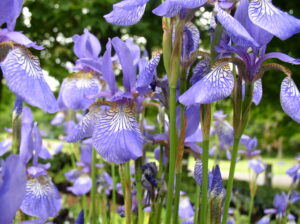
Iris
Iris bloom in Spring and early summer . Often we have a couple varieties of tall bearded iris and also several offerings of Siberian iris. Gardeners often feel that Siberian iris must be planted in damp or wet locations but that's not true. We have used them in shade gardens and open fields with equal success. We all wish that any iris would bloom longer but they do not. If you remember old New England farmhouses, they most all had bearded iris planted around the foundation adding color early on when winter was clearly history and summer was building.

Ligularia
Here's a plant that works well in shade gardens or gardens in full sun that have been constructed with plenty of organic material to hold moisture. Ligularia need consistent moisture and if you neglect that point, about two PM on a summer's day they will be pancake flat on the ground. They resurrect overnight but will repeat the "flat" part again if not watered. There are many, many varieties out there (well over 150) and they also self seed quite well. You must watch the temperate zone rating when making purchases because many are Zone 5 and above. I once received bad info about Greynog Gold which I always wanted. Bought it and two years later it was missing. Some have been reclassified as Farfugium. They are beauties with white or yellow spots--but they won't live here.

Lupines
New England gardeners seem to love lupines as the states of Maine and New Hampshire disagree over which one is the real "Eastern Lupine State". Maine should win as it used to have a native species that only grew there. We plant them each spring in 4" pots, 3-4 seeds per pot and sell them at the farm. Care is required when transplanting as each plant has a taproot that cannot be damaged less the plant looks great the first year and never returns. Mixed colors.

Monarda
Monarda, bee balm, Oswego Tea. A great pollinator plant available in a variety of heights and colors. Belongs to the mint family, hence the fragrance. We usually grow Jacob Cline, 5 feet tall and red, Garden Scarlet, Garden Marshall, Raspberry Wine and a couple of the new, shorter/18" tall varieties. Hummingbirds love monarda but truly, watch them for a while and try to figure out how they get anything out of the plant.

Penstemon
There are many varieties of penstemon from groundcover types to the +3 foot tall Dark Towers that we enjoy so much. Dark Towers matures to dark purple-burgundy stems and leaves, light lavender flowers and in our estimation it's most useful when it has set seed and the scapes, now full of seed pods, offer a different architecture to floral arrangements. Very hardy, long lasting, a pollinator plant for butterflies, bees and hummingbirds.
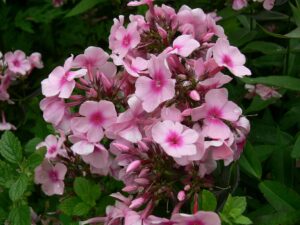
Phlox
Garden phlox is so popular in Vermont that the state university Plant & Soil Science department asked students to research the most effective anti-fungal spray to keep the plants looking nice. They arrived at baking soda mixed with water and dish detergent as a sticker. Trouble was that it took so much baking soda that it changed the pH of the soil....and created a different problem to contend with. Still not as big a problem as woodchucks which love them (echinacea too!!!) and will eat them to the ground in one night. Just the same we carry 6-15 varieties every year. Come see.

Primulas
Primroses are an easy to grow perennial that often self seeds providing plenty of plants and late spring garden colors. Japanese primroses shown here put up scapes with 4-5 circular tiers of bloom on each scape. There are dozens of varieties out there and there are several Vermont gardeners who are avid collectors and can help with information, sources, even plants for sale. Walk our hosta display garden and view a few. Always available potted for spring sales.

Pulmonaria
When we first moved to Marshfield, Amanda Legare who operates greenhouses in Cabot gave Gail a pulmonaria as a gift. I think it was one of those pass along deals as it didn't have a name but grew vigorously, was apricot colored, maybe 14" tall at maturity and it was a springtime magnet for the first hummingbirds to arrive. We were so happy with it we have been growing many pulmonarias ever since. Raspberry Splash, Bertram Anderson, Twinkle Toes, Silver Bouquet, Silver Shimmers, Little Star...the list goes on. Be prepared to dig and divide them every 4-5 years as the root systems need to rebuild themselves in about that amount of time. That's George's opinion anyway. Oh yes, and don't water them too much--dampness good, floating in water, not good.

Rodgersia
Here's a plant that made it's way back to England in the mid 1850's and then got to the US from there. Thick leaves on plants to 5 feet tall--leaves might remind of horse chestnut leaves. Leaves vary by variety--some stay green, others develop bronze edges, some are mostly bronze. Flowers from creamy white to reddish-pink to bronze too. Prefers a place with 50% shade, compost rich soil that retains consistent moisture. No deer would think of taking a bite.

Rudbeckia
Rudbeckias are members of the Aster family and are commonly found in America. Sometimes they are treated as an annual, sometimes as a perennial. Commonly known as Black Eyed Susans there are over 40 different varieties ranging in height, flower diameter and color. Probably the most common is Rudbeckia fulgida 'Goldsturm' but then there's the Rudbeckia 'Herbstsonne' pictured here which grows to 5-8 feet tall. At our farm, you will find it planted along fences where it provides some vertical to our gardens and draws attention. Some can handle our weather better, most all self seed to some degree.
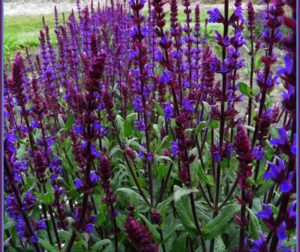
Salvia
Salvias are members of the Sage family which you might remember from culinary sage. They carry over that aroma to the point that some gardeners just don't like them. Fact is they won't be detectable unless the leaves are crushed. The bushy plants grow in the 20-24" tall range and flower in pinks, reds, raspberries, purples blues and whites. We haven't grow it in a few years but recommend Caradonna because it blooms all summer and reproduces easily. It also makes a nice little hedge or border. We typically have 3-4 different varieties each year.

Sambucus
Several years back we began carrying Sambucus racemosa 'Lemony Lace' and S. racemosa 'Black Lace' after seeing them at a botanical garden. They are listed at 5 feet tall but two years after selling a couple to a customer she returned with pictures of them at 6-7 feet tall in her garden. We like them because the white flowers attract butterflies and other pollinators and birds love the berries in the fall. What doesn't like them is white tailed deer so that's a plus too.

Sempervivums
These are perennial succulents which have grown in popularity along with the rise in fairy gardens and renewed interest in rock gardens. Common names are houseleeks (no relation at all to the leeks we eat) and liveforever--because they are so hardy. As they mature they produce a thick flower scape. The individual plant it grows from will die but the surrounding plants will continue. We also sell some succulents which are not weather hardy but are houseplants. They tend to be many times larger with very fleshy rosettes--nice but not hardy. Our gardening friend Kate Butler from Labour of Love Nursery & Landscaping in Glover, Vermont has one of the largest collections in New England.
Solomon Seal
Solomon's Seal or Polygonatum is a great plant to add to your shade gardens. It does best planted where it will receive some sunshine so just inside garden edges, along roadways or paths, but always where the soil tends to stay damp. The plant belongs to the lily family, includes about 60 varieties, and the mature plants including the seeds are poisonous. We always carry a fairly common one that reaches 3.5 feet tall and also a dwarf variety that reaches no more than 8" tall and can serve as a ground cover over time. Our gardening friend Marsha Russell has the best collection of polygonatum we know of.

Trollius
George first became interested in trollius when he noticed an entire front yard at a home in Old Bennington, Vermont that was planted in them. The inspiration led us to sell the plant whenever we can locate sources. It belongs to the ranunculus-buttercup family, blooms in late spring and will bloom again around Labor Day here if deadheaded earlier. If using for a cut flower, cut when blooms are half open and sear the end of the stem with a match. Guaranteed to make you smile!

Turtlehead
Turtlehead or chelone can be found in Vermont as a white blossomed native plant, Chelone glabra. Like the hybrids, its blooms form from mid August on. We have some growing on our Peacham property but it has never reached the 3' height some have suggested at maturity. We grow Chelone lyonii 'Hot Lips' which offers up bright pink blooms in later August. Some describe it as "invasive" but it is better described as "clumping heavily." Its added attribute is the fact that it's the home of the Baltimore Checkerspot butterfly. When these hatch, it's not uncommon to see 100- 300 at a time in the flower farm driveway drying their winds. Neat!!
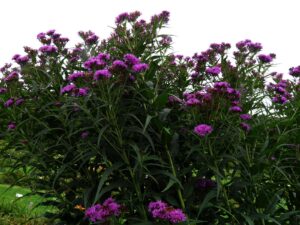
Vernonia
The common name for Vernonia is Ironweed and it's aptly named. When I first saw it I bought several gallon pots thinking I'd divide each plant into pieces and line them out to start my own supply. I truly almost cut my hand trying to get a knife through the roots. Like cutting iron for sure!! We like tall plants so Vernonia noveboracensis or New York Ironweed which reaches 8-9-10 feet tall is our favorite. We usually have some for sale but also carry more manageable 4-5 foot varieties. If you are into pollinators, any vernonia will please you. There are several examples in our daylily display garden down past our parking area. Go visit!

Veronica
Veronica is a popular perennial commonly known as Speedwell and also Bird's Eye around the US. There are over 500 varieties worldwide. The scapes grow 1-3 feet tall depending upon the variety and they are available in blue, purple, pink, red, white and shades of each. If you deadhead, they will provide subsequent blooms. All bees love them!

Veronicastrum
Veronicastrum, also known as Culver's Root, is a hardy perennial and a great pollinator plant. It's not always easy to find which always surprises us. The racemes will grow to +5 feet tall with dark green whorls of leaves. White, lilac-rose, purple. Availability not always consistent with demand here. Ask us if you cannot find it potted up.
